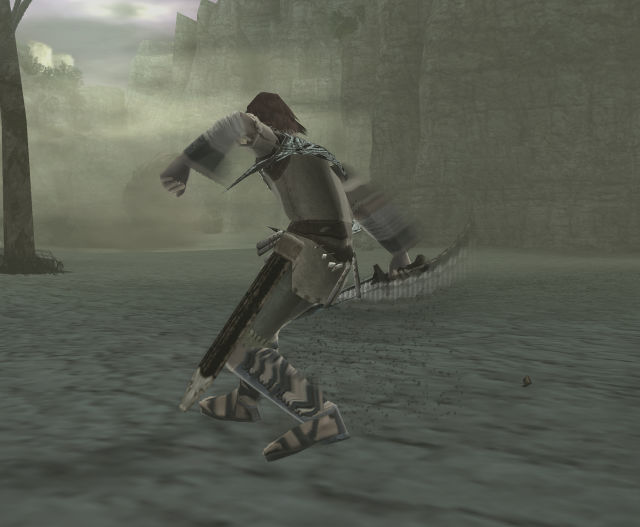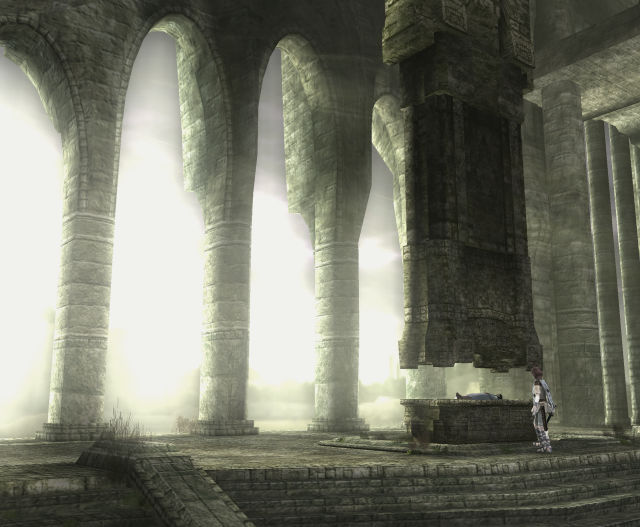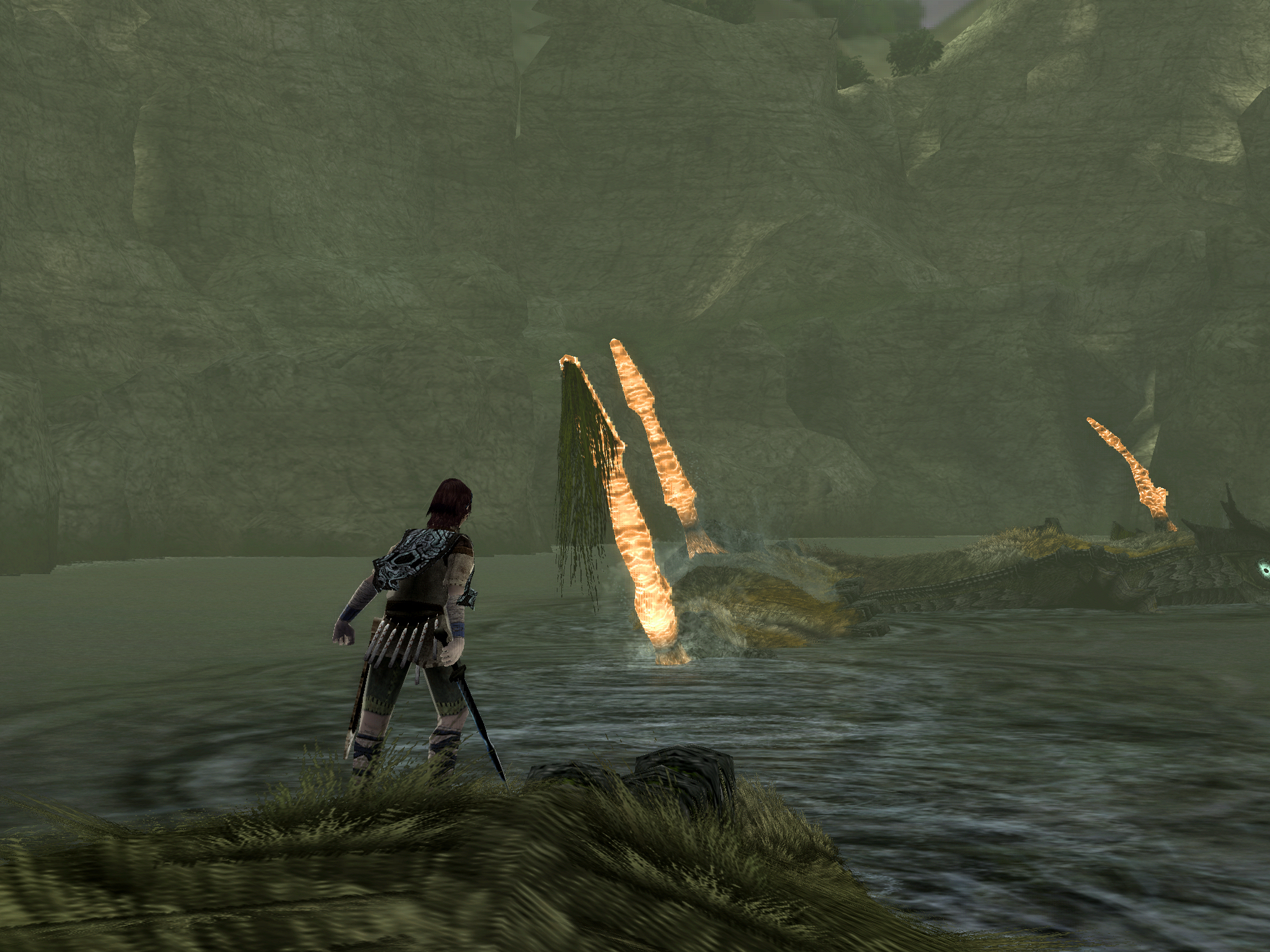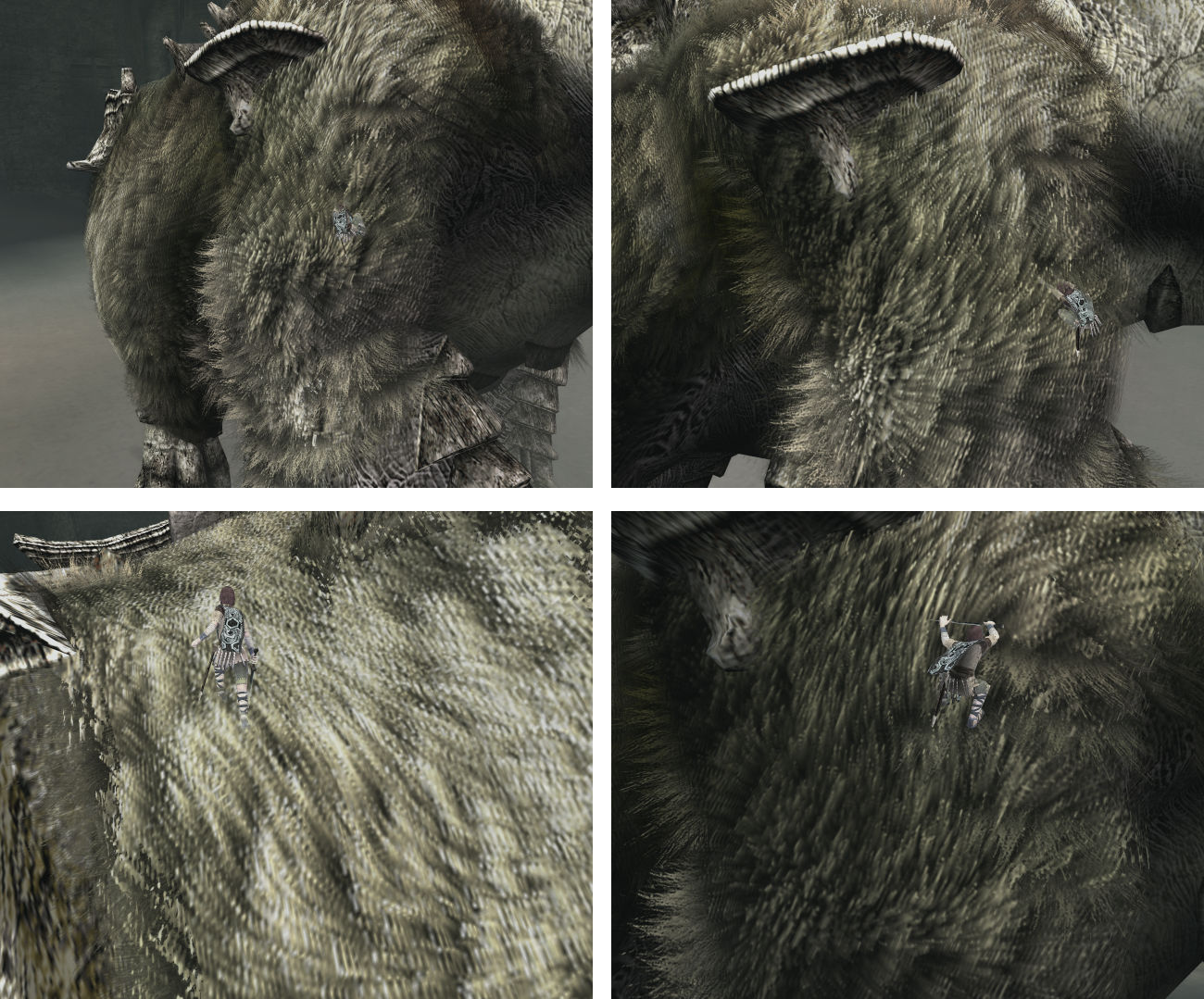Hey all, it's been a while since I've done one of these. The previous tech talk articles I've done focused on console hardware, but now I'm going to talk about software. Recently, I've been revisiting Shadow of the Colossus on my PS2, and I've been comparing it to the PS4 remake as well as the PS3 re-master. Before I start comparing anything, though, here's a refresher of just how crazy SOTC was on PS2. I'll refrain from getting too technical.
To begin, Shadow of the Colossus featured incredibly robust physics - which it needed when the game revolved around nothing but 16 colossal monsters. SOTC featured real time inverse kinematics calcuations - in English, this means that bone structures were recalculated on the fly to match the environment. For example, when the player character - "Wander" - did something as simple as walking up a hill, his feet would adjust with the slope.

The game featured other nice touches, such as an accumulative motion blur which became more intense as the camera panned more. SOTC's "making of" documents reveal that the motion blur is calculated by adjusting the environmental elements of the current frame based on camera velocity from the last frame, and then combining them. As well as that, this helped to make the drops below 30FPS - which were more frequent than you would like in battle, down to 20FPS and occasionally into the teens - much more tolerable and it also lent itself very nicely to the game's intricate animation. It never felt like a distraction from the overall visual presentation, either, and was one of the nicest implementations of motion blur on 6th generation hardware.

Now to get into some other serious stuff. Shadow of the Colossus was one of the only games of its time to simulate HDR rendering. Team ICO knew - as well as any developer who tried on any console hardware at the time - that real time HDR rendering simply wasn't possible on the hardware at the time. So Team ICO tried it anyway. The technique used in Shadow of the Colossus was an evolution of their use of bloom in ICO combined with some intelligently placed manual triggers. In the Shine of Worship at the beginning of the game, the windows and entrance have manually placed HDR triggers. This means that light on the outside is overwhelmingly bright and bloomed and - in turn - fonce you walk over the trigger and look back inside, the interior is extremely dark. It looks convincing, and in other areas of the game the white point is adjusted to give a HDR look as well.

Despite being in a lifeless land where no living soul has been for many years, water plays an integral role in parts of the game. You can swim in the water and as you swim ripples emerge behind you. You can also dive underwater and a nice screen distortion effect comes into play, as well as some more particles because you're, well, underwater. The same applies for the few colossi that inhabit water or lakes; they come to the surface, causing a splash and kicking up particles, and one of them descends back down into the water (see below) causing a few more particles as it immerses itself into the water again. SOTC also has some simple reflections, which is a simple but nice touch. They are not real time, from what I can tell, but they convincingly reflect the surrounding geometry and it looks completely fine in motion.

Additionally, one of the biggest features of this game's monsters are their fur. Pixel shading was not possible on PS2, and even then it was difficult to create convincing looking fur. So what they did, essentially, was they abused the PS2's bandwidth instead. For those who are not aware, the PS2's bandwidth was an astronomical 48GB/s, so in a game like Shadow of the Colossus at 30FPS they had 1.6GB of data to be freely manipulated per frame. It was a clever way of dodging the requirement of shaders and it was truly using the PS2 as the engineers intended. The fur was composed of 6 diffuse layers, with a new texture every 2 layers.

The fact that the fur was not just one texture, but three overlapping textures fused together gave it a remarkable sense of depth. Combined with a parallax effect, the end result was truly a spectacle and was some of the best fur you would see on hardware of its era.

So clearly, this was a technical masterpiece for the PS2 and was even a staple of technical progress for the 6th gen. The game ran at 512x448 to conserve video memory - and this is still double the pixel output of its predecessor ICO, which ran at 512x224 - but with 480p - or "progressive scan" mode - activated, this was increased to a full 640x448. Unfortunately, Shadow of the Colossus's technical wizardry came at a cost; framerate. SOTC struggled to maintain a consistent framerate on PS2 and often fell to 20FPS in taxing boss battles with about 20,000 polygons per boss in many cases. Despite this, the sheer technical achievements on display were enough to overlook this for many and it became a cult classic, releasing at the end of the PS2's life as a flagship in 2005.
Thankfully, Shadow of the Colossus didn't end there. SOTC was remastered for PS3 in 2011 along with ICO in a bundled remaster release. The game remained faithful to its roots, preserving most of the art and instead simply focusing on increasing resolution and touching up the game for PS3. The game was still quite difficult to run, however. Unlike ICO, which was remastered alongside it and ran at a beautiful 1920x1080p with MLAA anti-aliasing engaged, Shadow of the Colossus targeted 720p with MLAA instead. However, if you force 1080p output from your PS3, SOTC activates another interesting mode; 960x1080, with half the horizontal resolution of a true 1080p target, scaled on the fly with MLAA activated as usual. Some people may be distracted by the rectangular pixels, however, as similar to Mario Odyssey in Switch's portable mode (640x720) the game is trying to double the horizontal lines in game and this also augments the pixel-crawl artifacts which MLAA is a little bit notorious for.

Additionally, the HDR recreation is handled differently on PS3. While the overall technique remains the same, the resolution is changed up a bit in the process. During the rendering of a HDR scene, Shadow of the Colossus on PS2 made a black and white "mask" of the scene and this was sent to the Z-buffer (AKA the "depth" buffer) and downscaled with bilinear filtering to 64x64 to create a blurring effect. The PS3 version simply increases this downscaled resolution before the final Z-buffer result is composited back into the main scene, which gives a cleaner look to the lighting but it also makes the bloom somewhat lessened.
Shadow of the Colossus on PS3, by and large, improves the experience. At 720p, the game runs very consistently at 30FPS and looks pin-sharp. It's a great way to experience Shadow of the Colossus, even today. However, at 960x1080 and in 3D, things get worse. 960x1080 is a 12.5% increase in bandwidth and fillrate required for the PS3 GPU, and this just tips it over the edge - as I said, SOTC was not an easy game to run especially compared to ICO - and framerate noticeably begins to drop. It's not as bad as the PS2 version, but the game performs noticeably less consistently. 1080p mode still runs at 30FPS a lot of the time, but once you start grabbing onto the colossus and attacking, the framerate is liable to drop to the lower 20FPS region. In 3D, this is even worse, because the scene has to be rendered twice; 3D mode actually runs worse than the PS2 original, hitting as low as 10FPS on occasion and generally struggling to hit 30FPS with any sliver of consistency. Expect boss battles to be in the 20s, dropping into the teens as you start grappling with them. Digital Foundry did an excellent article on the differences and a performance analysis: you can check it out here.

The PS4 version of Shadow of the Colossus is a ground-up remake by Bluepoint, the same team behind the PS3 remaster, released in 2018. Bluepoint kept a sizable amount of the PS2/PS3 code intact, changing parts as necessary such as control schemes, and completely revamped the visual presentation. Fur is now authentically simulated, HDR is now actual HDR, and countless modern rendering techniques were introduced thanks to the visual rework.

Shadow of the Colossus on PS4 does a beautiful job of re-imagining SOTC for the current day. While the original will always be a piece of cult history, and while the remake sometimes fails to recreate the solemn and empty atmosphere of the original as a result of too much additional detail, the PS4 remake is simply exceptional. On a base PS4, SOTC operates at a full 1920x1080 at 30FPS with a sharp temporal anti-aliasing (TAA) technique in play. However, on PS4 Pro is where things get interesting. Due to the paltry amount of bandwidth the PS4 Pro has for a "4K" system, SOTC is simply unable to run at a full 4K; instead, Bluepoint have opted to operate at 1440p, just under half the pixels of a full 4K, at 30FPS. This still looks quite good as a nearly 2x boost over the base system, and temporal anti-aliasing keeps rough edges at bay. That isn't the full story though; the game also gives Pro users the option to play with a "Performance" mode. This drops the resolution to 1080p, but the game targets 60FPS instead for the first time. This is an incredibly fluid and responsive way to play the game, and TAA keeps the game looking respectably sharp even on a 4K display.

So with that all in mind, I think this wraps up the 3-way analysis and comparison of Shadow of the Colossus on 3 respective generations of hardware. If any of you have not played the game before, I recommend playing it - on any platform - and enjoying what is truly an experience and a game unlike any other. Thank you for reading and I hope you learned something from it! Remember to share this article if you found it informative, and share your thoughts in the comment section.
To begin, Shadow of the Colossus featured incredibly robust physics - which it needed when the game revolved around nothing but 16 colossal monsters. SOTC featured real time inverse kinematics calcuations - in English, this means that bone structures were recalculated on the fly to match the environment. For example, when the player character - "Wander" - did something as simple as walking up a hill, his feet would adjust with the slope.

The game featured other nice touches, such as an accumulative motion blur which became more intense as the camera panned more. SOTC's "making of" documents reveal that the motion blur is calculated by adjusting the environmental elements of the current frame based on camera velocity from the last frame, and then combining them. As well as that, this helped to make the drops below 30FPS - which were more frequent than you would like in battle, down to 20FPS and occasionally into the teens - much more tolerable and it also lent itself very nicely to the game's intricate animation. It never felt like a distraction from the overall visual presentation, either, and was one of the nicest implementations of motion blur on 6th generation hardware.

Now to get into some other serious stuff. Shadow of the Colossus was one of the only games of its time to simulate HDR rendering. Team ICO knew - as well as any developer who tried on any console hardware at the time - that real time HDR rendering simply wasn't possible on the hardware at the time. So Team ICO tried it anyway. The technique used in Shadow of the Colossus was an evolution of their use of bloom in ICO combined with some intelligently placed manual triggers. In the Shine of Worship at the beginning of the game, the windows and entrance have manually placed HDR triggers. This means that light on the outside is overwhelmingly bright and bloomed and - in turn - fonce you walk over the trigger and look back inside, the interior is extremely dark. It looks convincing, and in other areas of the game the white point is adjusted to give a HDR look as well.

Despite being in a lifeless land where no living soul has been for many years, water plays an integral role in parts of the game. You can swim in the water and as you swim ripples emerge behind you. You can also dive underwater and a nice screen distortion effect comes into play, as well as some more particles because you're, well, underwater. The same applies for the few colossi that inhabit water or lakes; they come to the surface, causing a splash and kicking up particles, and one of them descends back down into the water (see below) causing a few more particles as it immerses itself into the water again. SOTC also has some simple reflections, which is a simple but nice touch. They are not real time, from what I can tell, but they convincingly reflect the surrounding geometry and it looks completely fine in motion.

Additionally, one of the biggest features of this game's monsters are their fur. Pixel shading was not possible on PS2, and even then it was difficult to create convincing looking fur. So what they did, essentially, was they abused the PS2's bandwidth instead. For those who are not aware, the PS2's bandwidth was an astronomical 48GB/s, so in a game like Shadow of the Colossus at 30FPS they had 1.6GB of data to be freely manipulated per frame. It was a clever way of dodging the requirement of shaders and it was truly using the PS2 as the engineers intended. The fur was composed of 6 diffuse layers, with a new texture every 2 layers.

The fact that the fur was not just one texture, but three overlapping textures fused together gave it a remarkable sense of depth. Combined with a parallax effect, the end result was truly a spectacle and was some of the best fur you would see on hardware of its era.

So clearly, this was a technical masterpiece for the PS2 and was even a staple of technical progress for the 6th gen. The game ran at 512x448 to conserve video memory - and this is still double the pixel output of its predecessor ICO, which ran at 512x224 - but with 480p - or "progressive scan" mode - activated, this was increased to a full 640x448. Unfortunately, Shadow of the Colossus's technical wizardry came at a cost; framerate. SOTC struggled to maintain a consistent framerate on PS2 and often fell to 20FPS in taxing boss battles with about 20,000 polygons per boss in many cases. Despite this, the sheer technical achievements on display were enough to overlook this for many and it became a cult classic, releasing at the end of the PS2's life as a flagship in 2005.
Thankfully, Shadow of the Colossus didn't end there. SOTC was remastered for PS3 in 2011 along with ICO in a bundled remaster release. The game remained faithful to its roots, preserving most of the art and instead simply focusing on increasing resolution and touching up the game for PS3. The game was still quite difficult to run, however. Unlike ICO, which was remastered alongside it and ran at a beautiful 1920x1080p with MLAA anti-aliasing engaged, Shadow of the Colossus targeted 720p with MLAA instead. However, if you force 1080p output from your PS3, SOTC activates another interesting mode; 960x1080, with half the horizontal resolution of a true 1080p target, scaled on the fly with MLAA activated as usual. Some people may be distracted by the rectangular pixels, however, as similar to Mario Odyssey in Switch's portable mode (640x720) the game is trying to double the horizontal lines in game and this also augments the pixel-crawl artifacts which MLAA is a little bit notorious for.

Additionally, the HDR recreation is handled differently on PS3. While the overall technique remains the same, the resolution is changed up a bit in the process. During the rendering of a HDR scene, Shadow of the Colossus on PS2 made a black and white "mask" of the scene and this was sent to the Z-buffer (AKA the "depth" buffer) and downscaled with bilinear filtering to 64x64 to create a blurring effect. The PS3 version simply increases this downscaled resolution before the final Z-buffer result is composited back into the main scene, which gives a cleaner look to the lighting but it also makes the bloom somewhat lessened.
Shadow of the Colossus on PS3, by and large, improves the experience. At 720p, the game runs very consistently at 30FPS and looks pin-sharp. It's a great way to experience Shadow of the Colossus, even today. However, at 960x1080 and in 3D, things get worse. 960x1080 is a 12.5% increase in bandwidth and fillrate required for the PS3 GPU, and this just tips it over the edge - as I said, SOTC was not an easy game to run especially compared to ICO - and framerate noticeably begins to drop. It's not as bad as the PS2 version, but the game performs noticeably less consistently. 1080p mode still runs at 30FPS a lot of the time, but once you start grabbing onto the colossus and attacking, the framerate is liable to drop to the lower 20FPS region. In 3D, this is even worse, because the scene has to be rendered twice; 3D mode actually runs worse than the PS2 original, hitting as low as 10FPS on occasion and generally struggling to hit 30FPS with any sliver of consistency. Expect boss battles to be in the 20s, dropping into the teens as you start grappling with them. Digital Foundry did an excellent article on the differences and a performance analysis: you can check it out here.

The PS4 version of Shadow of the Colossus is a ground-up remake by Bluepoint, the same team behind the PS3 remaster, released in 2018. Bluepoint kept a sizable amount of the PS2/PS3 code intact, changing parts as necessary such as control schemes, and completely revamped the visual presentation. Fur is now authentically simulated, HDR is now actual HDR, and countless modern rendering techniques were introduced thanks to the visual rework.

Shadow of the Colossus on PS4 does a beautiful job of re-imagining SOTC for the current day. While the original will always be a piece of cult history, and while the remake sometimes fails to recreate the solemn and empty atmosphere of the original as a result of too much additional detail, the PS4 remake is simply exceptional. On a base PS4, SOTC operates at a full 1920x1080 at 30FPS with a sharp temporal anti-aliasing (TAA) technique in play. However, on PS4 Pro is where things get interesting. Due to the paltry amount of bandwidth the PS4 Pro has for a "4K" system, SOTC is simply unable to run at a full 4K; instead, Bluepoint have opted to operate at 1440p, just under half the pixels of a full 4K, at 30FPS. This still looks quite good as a nearly 2x boost over the base system, and temporal anti-aliasing keeps rough edges at bay. That isn't the full story though; the game also gives Pro users the option to play with a "Performance" mode. This drops the resolution to 1080p, but the game targets 60FPS instead for the first time. This is an incredibly fluid and responsive way to play the game, and TAA keeps the game looking respectably sharp even on a 4K display.

So with that all in mind, I think this wraps up the 3-way analysis and comparison of Shadow of the Colossus on 3 respective generations of hardware. If any of you have not played the game before, I recommend playing it - on any platform - and enjoying what is truly an experience and a game unlike any other. Thank you for reading and I hope you learned something from it! Remember to share this article if you found it informative, and share your thoughts in the comment section.
 Splinter Cell: Chaos Theory
Splinter Cell: Chaos Theory